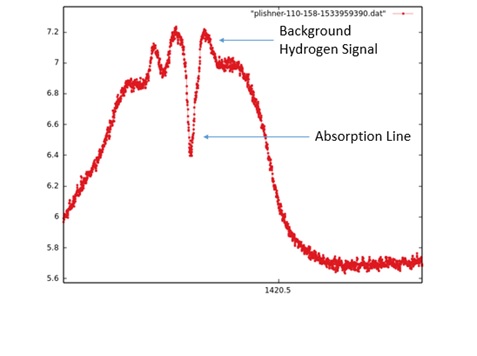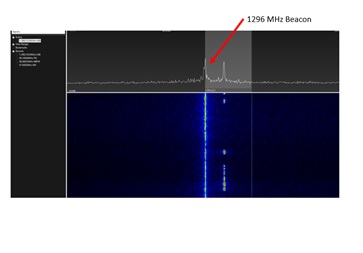Please click to open and read the DSES Engineering Meeting Minutes of August 13, 2018. – Bill Miller
Tag: Observations
Observations using the 60-foot Dish during the Open House, August 11, 2018
Editor’s note: During the DSES Open House on the weekend of August 11, 2018, three receiver systems were tested on the 60-foot dish antenna. Dr. Richard Russel reports on their successful results, and he shows what we see in our data plots. Some highlights to point out:
- The Spectracyber definitively observed the neutral hydrogen of the Milky Way as the beam width completely crossed the galactic plane.
- The RASDR4 observed a known neutral hydrogen radio source, which has a closer cloud along the line of sight that absorbs some of the hydrogen signal. The distinctive signal feature is known from published data by the Parkes Radio Observatory in Australia.
- The RASDR2 detected a 1296 MHz beacon set up at the home of a member about 80 miles away. This is our first definitive detection of a beacon at 1296 MHz.
-Gary Agranat, website editor.
Open House Observations using the 60-foot Dish Antenna
The DSES and Society of Amateur Radio Astronomers (SARA) teams installed three different receivers onto the 60-foot dish during the open house.
Successful Installation and Testing of the DSES Spectracyber Neutral Hydrogen Receiver.
The Spectracyber was installed on the 60-foot dish during the DSES Open House on August 11, 2018.
The Spectracyber measures 1420.406 MHz +- 600 KHz. The observation was taken while passing the galactic plane at RA: 19hr 5 Min, Dec: 6 degrees 0 Min.
The observation shows a significant signal to noise ratio as seen below.

Follow-on observations will allow for measurement of the rotation rate of the Milky Way and Solar System!
RASDR4 Receiver Successful Observation of Hydrogen Absorption Line
Tony Bigbee used his RASDR4 on the 60-foot dish to observe this hydrogen absorption line at RA: 18.15hrs, Dec:-20 deg.
This target is a hydrogen source with a cloud of material between the source and Earth that absorbs the hydrogen energy resulting in a drop off of signal as shown below.

1296 MHz Beacon Observation using a RASDR2
Bogdan Vacaliuc installed a RASDR2 onto the 60-foot dish and was able to observe the 1296 MHZ beacon at Ray Uberecken’s house, about 80 statute miles distance to the west-northwest. This observation helped verify the azimuth pointing accuracy of the 60-foot dish.

Greenbank & Haswell plots of simultaneous observation of NRAO 5690 on August 15, 2018
 The following is a comparison of simultaneous observations made on August 15, 2018 of the astronomical radio source, NRAO 5690.
The following is a comparison of simultaneous observations made on August 15, 2018 of the astronomical radio source, NRAO 5690.
The first plot is an observation made by Skip Crilly at the 4o foot radio telescope at Greenbank Observatory in West Virginia. The second plot is an observation made by Steve Plock at the DSES Plishner 60-foot antenna in Haswell, Colorado.


NRAO 5690 is a catalogued supernova remnant (SNR), with the celestial coordinate location of 18 hours 35 minutes Right Ascension and -7 degrees 20 minutes Declination. It is known to have an apparent radio brightness of 90 Janskies at 1.4 GHz *(1).
Each observation was made by Drift Scan. Drift scan is fixing the azimuth (left-right) direction of the antenna, and scanning the sky as the Earth rotates. For each dish antenna, the elevation above the horizon is also fixed. As the Earth turns (at a quarter of a degree per minute), each antenna can detect radio source objects within its sensitivity, as the objects cross the beam width.
The observation at Haswell was done during a 42 hour drift scan at -7.6 degrees declination, in support of the joint SETI (Search for Extraterrestrial Intelligence) work between DSES and Skip Crilly *(2). The dual plots show we are observing the same astronomical object at known pointing angles, and is a good verification of the two systems observing together.
1. Reference: NRAO VLA 1.4 GHz survey.
2. Geographically-spaced Synchronized Signal Detection System” by Skip Crilly. Presentation on June 11, 2018 at the Society of Amateur Radio Astronomers Conference Green Bank Observatory, West Virginia, USA